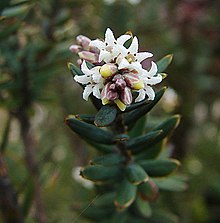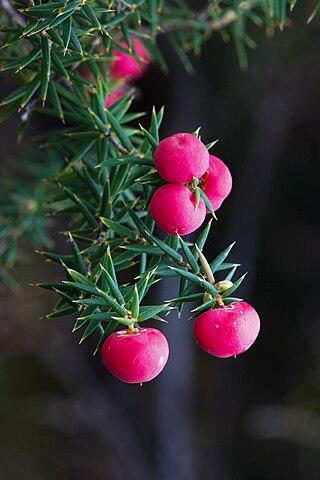
The Ericaceae are a family of flowering plants, commonly known as the heath or heather family, found most commonly in acidic and infertile growing conditions. The family is large, with c. 4250 known species spread across 124 genera, making it the 14th most species-rich family of flowering plants. The many well known and economically important members of the Ericaceae include the cranberry, blueberry, huckleberry, rhododendron, and various common heaths and heathers.

Cassiope is a genus of 9-12 small shrubby species in the family Ericaceae. It is the sole genus in the subfamily Cassiopoideae. They are native to the Arctic and north temperate montane regions. The genus is named after Cassiopeia of Greek mythology. Common names, shared with several other similar related genera, include heather and heath. They have scale-like leaves lying against the stems, and produce solitary bell-shaped flowers in late spring. Though hardy, flowers can be damaged by late frosts.

Leucopogon is a genus of about 150-160 species of shrubs or small trees in the family Ericaceae, in the section of that family formerly treated as the separate family Epacridaceae. They are native to Australia, New Zealand, New Caledonia, the western Pacific Islands and Malaysia, with the greatest species diversity in the south-west of Western Australia. Plants in this genus have leaves with a few more or less parallel veins, and tube-shaped flowers usually with a white beard inside.

Epacris is a genus of about forty species of flowering plants in the family Ericaceae. It was formerly treated in a closely related but separate family Epacridaceae, but the various genera within Epacridaceae including Epacris have been revised in their relationships to each other and brought under the common umbrella of the Ericaceae. The genus Epacris is native to eastern and southeastern Australia, New Caledonia and New Zealand. The species are known as heaths or Australian heaths.
Rupicola is a small genus of flowering plants in the family Ericaceae. The species are endemic to New South Wales in Australia.

Woollsia is a monotypic genus in the family Ericaceae. The sole species, Woollsia pungens, known as snow heath, is a small shrub found in eastern Australia, from Pigeon House Mountain in southern New South Wales north into Queensland.
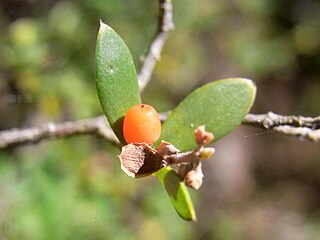
Acrotriche is a genus of flowering plants in the family Ericaceae. Species occur in all states of Australia. They include:

Richea is a genus of 11 species of flowering plants in the family Ericaceae. Nine of the species are endemic to Tasmania and the other two are endemic to the south-east of the Australian mainland.

Brachyloma is a genus of about 16 species of flowering plants in the family Ericaceae and is endemic to Australia. Plants in the genus Brachyloma are shrubs with more or less erect leaves and bisexual flowers usually arranged singly in leaf axils, the 5 petals fused to form a cylindrical or bell-shaped tube, the stamens sometimes enclosed in the petal tube.

Archeria is a small genus of shrubs in the family Ericaceae. As currently circumscribed the group includes six species, all native to southern Australasia. Four of these are endemic to Tasmania, and the other two endemic to New Zealand.

Archeria hirtella is a species of shrub in the family Ericaceae. It is native to Tasmania, Australia.
Cheilotheca is a small genus of myco-heterotrophic plants in the family (Ericaceae). As currently circumscribed the group includes three species.
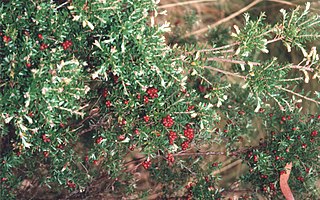
Acrothamnus hookeri, commonly known as the mountain beardheath, is a flowering plant in the family Ericaceae and grows in subalpine regions of southeastern Australia. It is a small upright shrub with oblong-shaped leaves and white flowers.
Budawangia is a monotypic genus of flowering plants in the family Ericaceae. The sole species is Budawangia gnidioides from New South Wales. The genus was formally described in 1992.

Acrothamnus colensoi is a species of plant in the family Ericaceae, that is endemic to New Zealand. It is a small shrub that grow to approximately 50 cm tall, and that can spread to form mounds of up to 2 m across. Fruit are round and are white, pink or dark red in colour. It can be found in both the North and South Islands, in scrub, tussock grassland and peat bogs, south of the Kaingaroa Forest.
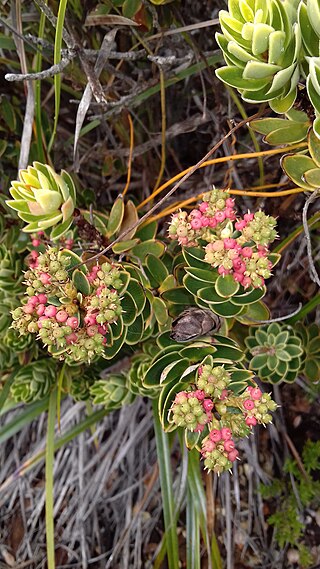
Cyathopsis is a genus of shrubs in the family Ericaceae. The genus is endemic to New Caledonia in the Pacific and contains three species that have previously been included in Styphelia. It is related to genera such as Leucopogon, Lissanthe and Styphelia.

Androstoma is a genus of flowering plants belonging to the family Ericaceae.
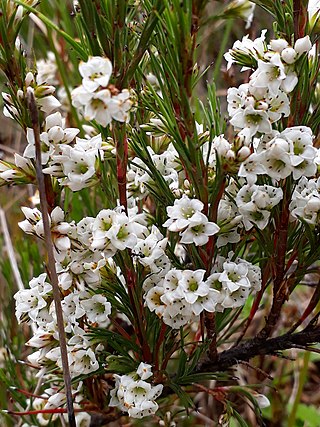
Dracophyllum scoparium is a species of shrub or small tree endemic to the Chatham Islands of New Zealand. It was first described by Joseph Dalton Hooker in 1844 and gets the specific epithet scoparium, in the form of a broom, for the way in which its juvenile leaves grow. In the heath family Ericaceae, it inhabits the Chatham and Pitt Islands, and reaches a height of 1–4 m.
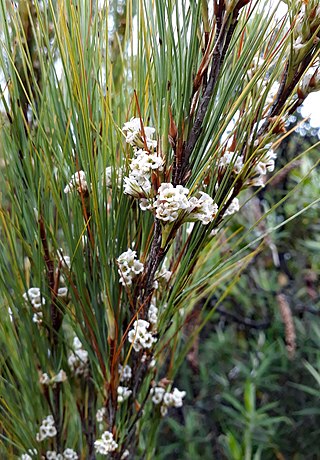
Dracophyllum filifolium is a species of shrub or tree endemic to the North, South, and Stewart Islands of New Zealand. It was first described by Joseph Dalton Hooker in 1853 and gets the specific epithet filifolium for its leaves being like a filament. In the heath family Ericaceae, it inhabits mountain slopes, saddles and ridges and reaches a height of 1–4 m (3–13 ft). A 2017 assessment using the New Zealand Threat Classification System classified it as “Not Threatened,” giving it an estimated population of more than 100,000.

Epacridoideae is a subfamily of the family Ericaceae. The name StyphelioideaeSweet is also used. The subfamily contains around 35 genera and 545 species. Many species are found in Australasia, others occurring northwards through the Pacific to Southeast Asia, with a small number in South America.
